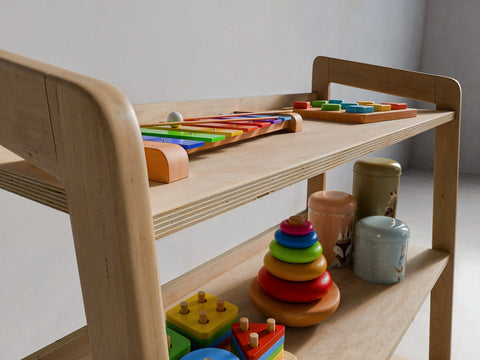Designing your child’s space is about more than just style—it’s about creating a safe, functional, and sustainable environment that supports their growth. Child-friendly furniture is carefully crafted to balance safety, ergonomics, and sustainability, meeting the unique needs of growing children while being mindful of the planet. Here’s what you need to know when making your choices.
Safety as the Foundation of Child-Friendly Furniture
Safety is the cornerstone of child-friendly furniture. Children are naturally curious and active, so each piece should minimize risks. Rounded edges help prevent injuries, while non-toxic materials protect children from harmful chemicals. For example, using eco-friendly, child-safe finishes ensures a healthier environment for your little one.
Sturdy construction is crucial, especially for larger items like shelves, which should be secured to the wall. Soft-close mechanisms on drawers and lids add another layer of safety, protecting fingers from accidental pinches.
When choosing furniture, prioritize:
- Rounded edges to reduce injury risks.
- Sustainably sourced wood with non-toxic finishes.
- Sturdy designs to prevent tipping hazards.
- Features like soft-close systems for enhanced safety.
Ergonomics for Growing Bodies
Proper ergonomics are essential for your child’s comfort and health as they grow. Child-Friendly furniture should fit your child’s size, allowing their feet to rest flat on the floor when seated, which encourages good posture.
Choosing the right size furniture ensures both comfort and functionality, supporting your child’s physical development over time. Additionally, chairs with adequate lumbar support help promote healthy spinal alignment, especially during study or play.
Child-Friendly Furniture Encouraging Independence Through Design
The design of a child’s furniture plays a significant role in fostering independence. Low shelves and accessible storage units empower children to organize their belongings, teaching responsibility and decision-making. Multifunctional furniture, like desks that double as creative workstations, encourages adaptability and inspires imagination.
Colour is another factor that supports independence and creativity. Bright, cheerful tones stimulate energy and curiosity, while softer, neutral hues create a calm and focused atmosphere. Thoughtfully designed furniture encourages children to take ownership of their space, fostering both independence and creativity.
Raw Child-Friendly Furniture: A Feast for Your Imagination!
If you’re considering raw, unfinished furniture, why not make it a family project? Painting it together with your child can be a wonderful way to spark their imagination while adding a personal touch to their space. This collaborative activity not only makes the furniture unique, but also gives your child a sense of pride and ownership in their room.
Sustainability: Teaching Lifelong Responsibility
- Eco-friendly furniture teaches environmental awareness.
- Made from responsibly sourced wood or bamboo, it’s durable and sustainable.
- Repurposable or recyclable designs reduce waste and offer a timeless aesthetic.
- High-quality, long-lasting furniture minimizes environmental impact.
Why It Matters?
Investing in child-friendly furniture goes beyond practicality—it’s about creating a nurturing space where children can grow, learn, and thrive. By prioritizing safety, ergonomics, and sustainability, you’re building an environment that supports both their physical and emotional development.
Thoughtful furniture choices are an investment in your child’s future, promoting independence, creativity, and environmental responsibility. When you select furniture made from responsibly sourced wood or crafted with a timeless design, you’re helping create a space that truly grows with your child.




